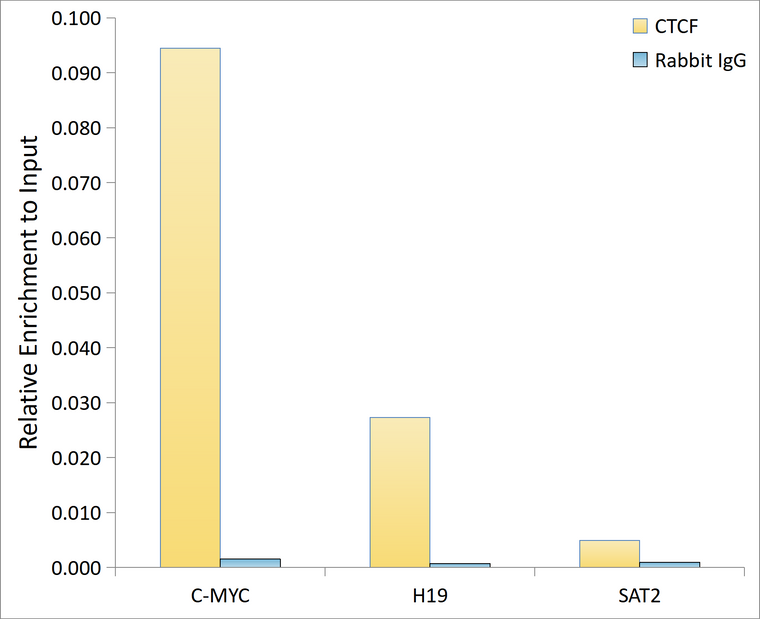| Host: |
Rabbit |
| Applications: |
WB/IF/IP |
| Reactivity: |
Human/Mouse/Rat |
| Note: |
STRICTLY FOR FURTHER SCIENTIFIC RESEARCH USE ONLY (RUO). MUST NOT TO BE USED IN DIAGNOSTIC OR THERAPEUTIC APPLICATIONS. |
| Short Description: |
Rabbit polyclonal antibody anti-CTCF (1-260) is suitable for use in Western Blot, Immunofluorescence and Immunoprecipitation research applications. |
| Clonality: |
Polyclonal |
| Conjugation: |
Unconjugated |
| Isotype: |
IgG |
| Formulation: |
PBS with 0.05% Proclin300, 50% Glycerol, pH7.3. |
| Purification: |
Affinity purification |
| Dilution Range: |
WB 1:500-1:1000IF/ICC 1:50-1:200IP 1:100-1:500ChIP 1:50-1:200 |
| Storage Instruction: |
Store at-20°C for up to 1 year from the date of receipt, and avoid repeat freeze-thaw cycles. |
| Gene Symbol: |
CTCF |
| Gene ID: |
10664 |
| Uniprot ID: |
CTCF_HUMAN |
| Immunogen Region: |
1-260 |
| Immunogen: |
Recombinant fusion protein containing a sequence corresponding to amino acids 1-260 of human CTCF (NP_006556.1). |
| Immunogen Sequence: |
MEGDAVEAIVEESETFIKGK ERKTYQRRREGGQEEDACHL PQNQTDGGEVVQDVNSSVQM VMMEQLDPTLLQMKTEVMEG TVAPEAEAAVDDTQIITLQV VNMEEQPINIGELQLVQVPV PVTVPVATTSVEELQGAYEN EVSKEGLAESEPMICHTLPL PEGFQVVKVGANGEVETLEQ GELPPQEDPSWQKDPDYQPP AKKTKKTKKSKLRYTEEGKD VDVSVYDFEEEQQEGLLSE |
| Tissue Specificity | Ubiquitous. Absent in primary spermatocytes. |
| Post Translational Modifications | Sumoylated on Lys-74 and Lys-689.sumoylation of CTCF contributes to the repressive function of CTCF on the MYC P2 promoter. |
| Function | Chromatin binding factor that binds to DNA sequence specific sites. Involved in transcriptional regulation by binding to chromatin insulators and preventing interaction between promoter and nearby enhancers and silencers. Acts as transcriptional repressor binding to promoters of vertebrate MYC gene and BAG1 gene. Also binds to the PLK and PIM1 promoters. Acts as a transcriptional activator of APP. Regulates APOA1/C3/A4/A5 gene cluster and controls MHC class II gene expression. Plays an essential role in oocyte and preimplantation embryo development by activating or repressing transcription. Seems to act as tumor suppressor. Plays a critical role in the epigenetic regulation. Participates in the allele-specific gene expression at the imprinted IGF2/H19 gene locus. On the maternal allele, binding within the H19 imprinting control region (ICR) mediates maternally inherited higher-order chromatin conformation to restrict enhancer access to IGF2. Plays a critical role in gene silencing over considerable distances in the genome. Preferentially interacts with unmethylated DNA, preventing spreading of CpG methylation and maintaining methylation-free zones. Inversely, binding to target sites is prevented by CpG methylation. Plays an important role in chromatin remodeling. Can dimerize when it is bound to different DNA sequences, mediating long-range chromatin looping. Mediates interchromosomal association between IGF2/H19 and WSB1/NF1 and may direct distant DNA segments to a common transcription factory. Causes local loss of histone acetylation and gain of histone methylation in the beta-globin locus, without affecting transcription. When bound to chromatin, it provides an anchor point for nucleosomes positioning. Seems to be essential for homologous X-chromosome pairing. May participate with Tsix in establishing a regulatable epigenetic switch for X chromosome inactivation. May play a role in preventing the propagation of stable methylation at the escape genes from X- inactivation. Involved in sister chromatid cohesion. Associates with both centromeres and chromosomal arms during metaphase and required for cohesin localization to CTCF sites. Regulates asynchronous replication of IGF2/H19. Plays a role in the recruitment of CENPE to the pericentromeric/centromeric regions of the chromosome during mitosis. |
| Protein Name | Transcriptional Repressor Ctcf11-Zinc Finger ProteinCcctc-Binding FactorCtcfl Paralog |
| Database Links | Reactome: R-HSA-5617472 |
| Cellular Localisation | NucleusNucleoplasmChromosomeCentromereMay Translocate To The Nucleolus Upon Cell DifferentiationAssociates With Both Centromeres And Chromosomal Arms During MetaphaseAssociates With The H19 Icr In Mitotic ChromosomesMay Be Preferentially Excluded From Heterochromatin During Interphase |
| Alternative Antibody Names | Anti-Transcriptional Repressor Ctcf antibodyAnti-11-Zinc Finger Protein antibodyAnti-Ccctc-Binding Factor antibodyAnti-Ctcfl Paralog antibodyAnti-CTCF antibody |
Information sourced from Uniprot.org
12 months for antibodies. 6 months for ELISA Kits. Please see website T&Cs for further guidance










![Chromatin immunoprecipitation analysis of extracts of HeLa cells, using [KD Validated] CTCF Rabbit polyclonal antibody (STJ11100563) and rabbit IgG. The amount of immunoprecipitated DNA was checked by quantitative PCR. Histogram was constructed by the ratios of the immunoprecipitated DNA to the input. Chromatin immunoprecipitation analysis of extracts of HeLa cells, using [KD Validated] CTCF Rabbit polyclonal antibody (STJ11100563) and rabbit IgG. The amount of immunoprecipitated DNA was checked by quantitative PCR. Histogram was constructed by the ratios of the immunoprecipitated DNA to the input.](https://cdn11.bigcommerce.com/s-zso2xnchw9/images/stencil/300x300/products/89614/358098/STJ11100563_1__34552.1713122383.jpg?c=1)

